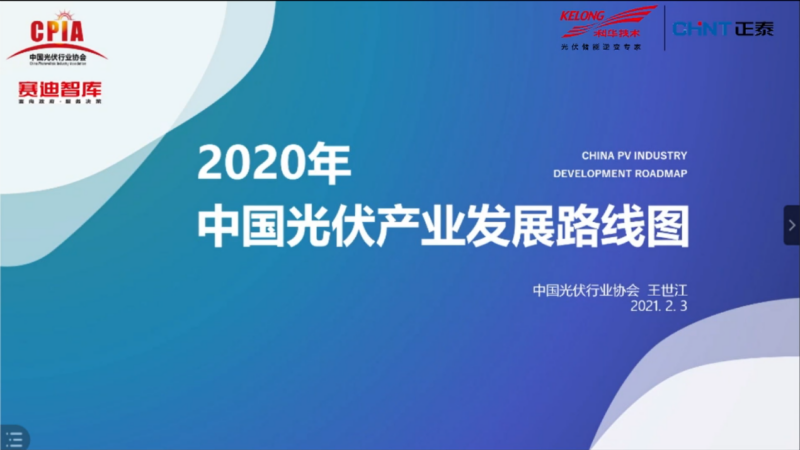Module prices will fall, cell conversion efficiency will rise, and glass prices will return to rational prices
PVTIME – Yesterday, Wang Shijiang, the Deputy Secretary-General of China Photovoltaic Industry Association (CPIA), presented the 2020 roadmap for the Chinese photovoltaic industry during the “2020 Photovoltaic Development Review and 2021 Outlook Conference”.

The roadmap which includes 61 key indicators was formulated by CPIA and CCID Think Tank under the guidance of the Ministry of Industry and Information Technology and covers the upstream and downstream links of the photovoltaic industry chain.
According to Wang Shijiang, the roadmap has finally been completed after three months of data collection and expert review. It is hoped that through the release of the roadmap, the core competitiveness of China’s PV industry will be further enhanced, the pace of innovation accelerated, and the model of cross-domain collaboration transformed.
“From silicon wafer size to wafer output per capita, the PV industry’ development trends are fully reflected in the fluctuations in the 61 key indicators,” Wang said. The CPIA has been sharing its PV industry development roadmap for five consecutive years and the indicators have been adjusted each year to reflect market and technology changes.
The roadmap fully illustrates the technological progress of the domestic photovoltaic industry. According to the report, the power consumption of producing a kilogram of polysilicon has been reduced from about 80kWh per kilogram in 2016 to 66.5kWh in 2020. By 2030, the power consumption of producing a kilogram of polysilicon is predicted to drop to 60kWh per kilogram. The equipment investment cost of a thousand-tonne polysilicon production line has also decreased from about 150 million to about 100 million yuan. In terms of wafer thickness, monocrystalline wafers have decreased from 190μm to 175μm, and polycrystalline wafers have decreased from 188μm to 180μm. In 2016, the market share of full-cell modules was 99%, and by 2020, the market share of half-cell modules reached 71%.
Wang Shijiang believes module prices will go down and said that the localization of cell production equipment will play a very important role in improving the core competitiveness of the industry. In 2015, the cost of producing a MW was 600,000 yuan. By 2020, the cost has dropped down to 225,000 yuan per MW, directly driving the investment cost of the entire system from 7.6 yuan per watt to 4 yuan in 4 years. During this time, the price of modules has also dropped from 3.3 yuan per watt to 1.57 per watt.
In 2020, monocrystalline silicon wafers will dominate, and the proportion of polycrystalline silicon wafers will diminish. By 2030, n-type silicon wafers and p-type silicon wafers will see equal application usage. In terms of wafer size, 158mm and 166mm are still the norm. However, it is expected that the adoption rate of 182mm and 210mm silicon wafers will grow rapidly. It is an inevitable trend for silicon wafers to develop into larger sizes.
In terms of battery conversion efficiency, the report predicts that the PERC cell will maintain growth in the future. According to statistics, the conversion efficiency of PERC cells will be about 22.8% in 2020, and it is estimated that the conversion efficiency of PERC cells will exceed 24% by 2030. Wang Shijiang stressed that with the progress of technology, the improvement of material performance, and the improvement of equipment processing capabilities, there may be more surprises in the future! According to the analysis on cell technology market share, PERC currently dominates with 80%. In the future, with the expansion of high-efficiency cell demand, n-class cells will occupy a certain portion of the market in 2030, and PERC and TOPCon cells will be the primary players.
“After glass returns to rational price levels, bifacial modules will gradually move to a dominant position in the market,” Wang Shijiang said. Monofacial modules had a 74% market share in 2020. However, if glass prices come back down to a rational level, the market share of bifacial modules is expected to reach 75% by 2030.
In terms of inverter market share, string inverters are dominating and there will be no change in the short-term.
Finally, regarding investing in ground photovoltaic power stations, the cost in 2020 was approximately 4 yuan per watt, of which module costs accounted for 39%. Wang Shijiang predicts that as the price of raw and auxiliary materials falls, the investment cost of ground power stations in 2021 will drop to 3.8 yuan per watt. In terms of investing in industrial and commercial distributed photovoltaic systems, the cost in 2020 was approximately 3.38 yuan per watt and is expected to drop to 3.24 yuan per watt in 2021.










